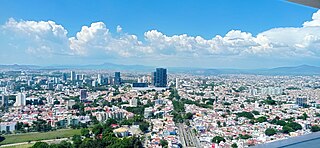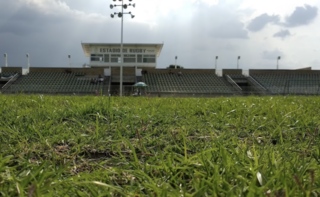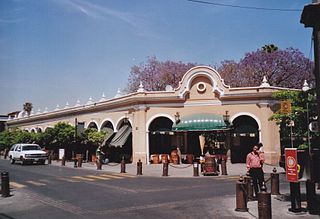Related Research Articles

Tlaquepaque, officially San Pedro Tlaquepaque, is a city and the surrounding municipality in the Mexican state of Jalisco.

The Royal Alcázars of Seville, historically known as al-Qasr al-Muriq and commonly known as the Alcázar of Seville, is a royal palace in Seville, Spain, built for king Peter of Castile. It was built by the Castilians on the site of an Abbadid alcázar, or residential fortress. The fortress was destroyed after the Castilian conquest of Seville in 1248.

The Guadalajara metropolitan area is the most populous metropolitan area of the Mexican state of Jalisco and the third largest in the country after Greater Mexico City and Monterrey. It includes the core municipality of Guadalajara and the surrounding municipalities of Zapopan, Tlaquepaque, Tonalá, Tlajomulco de Zúñiga, El Salto, Ixtlahuacán de los Membrillos and Juanacatlán.

Patio Maravillas was a multi-purpose self-managed social centre which occupied several spaces in central Madrid between 2007 and 2015.
The following radio stations broadcast on AM frequency 1070 kHz: The Federal Communications Commission classifies 1070 AM as a United States and Canadian clear-channel frequency. KNX in Los Angeles and CBA in Moncton, New Brunswick shared Class A status on this frequency. But on April 7, 2008, CBA moved to the FM dial.

Susana Guenola Zubiri is an Argentine actress. She appeared in 30 films and television shows between 1945 and 1984. She starred in the film Three Loves in Rio, which was entered into the 9th Berlin International Film Festival.

Tlaquepaque Stadium is a 1,360 seat stadium that was built in 2011 to host the rugby sevens competition at the 2011 Pan American Games and the 2023 Gay Games.

The Museo Regional de la Cerámica in Tlaquepaque, Jalisco, Mexico is located on Independencia Street in the center of the city. The museum is one of two main ceramics museums in the city, with the other being the Pantaleon Panduro Museum. It was established in 1954 to preserve and promote indigenous handcrafts of Jalisco, especially the state’s ceramic tradition. The emphasis is still on ceramics but the museum also has a room dedicated to Huichol art and holds events related to various types of indigenous crafts and culture.

Ceramics of Jalisco, Mexico has a history that extends far back in the pre Hispanic period, but modern production is the result of techniques introduced by the Spanish during the colonial period and the introduction of high-fire production in the 1950s and 1960s by Jorge Wilmot and Ken Edwards. Today various types of traditional ceramics such as bruñido, canelo and petatillo are still made, along with high fire types like stoneware, with traditional and nontraditional decorative motifs. The two main ceramics centers are Tlaquepaque and Tonalá, with a wide variety of products such as cookware, plates, bowls, piggy banks and many types of figures.

Jalisco handcrafts and folk art are noted among Mexican handcraft traditions. The state is one of the main producers of handcrafts, which are noted for quality. The main handcraft tradition is ceramics, which has produced a number of known ceramicists, including Jorge Wilmot, who introduced high fire work into the state. In addition to ceramics, the state also makes blown glass, textiles, wood furniture including the equipal chair, baskets, metal items, piteado and Huichol art.
The Nueva Plaza Cartel is a Mexican criminal organization from the state of Jalisco. The group began as a split from the Jalisco New Generation Cartel, having an important presence in the Guadalajara metropolitan area, having been previously commanded by Carlos Enrique Sánchez Martínez, "El Cholo," Emilio Alejandro Pulido Saldaña, "El Tiburón," and Érick Valencia Salazar "El 85". El Cholo would be killed in 2021, with "El Tiburón" surrendering himself to Mexican authorities soon afterwards. El 85 would be arrested in 2022.

Jardín Hidalgo is a plaza in Tlaquepaque, in the Mexican state of Jalisco.

Puente Artesanal is a bridge and sign denoting the entrance to Tlaquepaque, in the Mexican state of Jalisco.

El Parián is a historic structure and tourist attraction in Tlaquepaque, in the Mexican state of Jalisco.

El grito continua is a 2010 sculpture by Camilo Ramírez, installed in Tlaquepaque, in the Mexican state of Jalisco.

El Señor de los Monitos, or simply El Señor Monitos, is a sculpture in Tlaquepaque, in the Mexican state of Jalisco. Camilo Ramírez made this piece in 2020. The statue is six meters tall and weighs 1.5 tons.
References
- ↑ "El Patio de Tlaquepaque on Alma Latina" . Retrieved December 10, 2014.